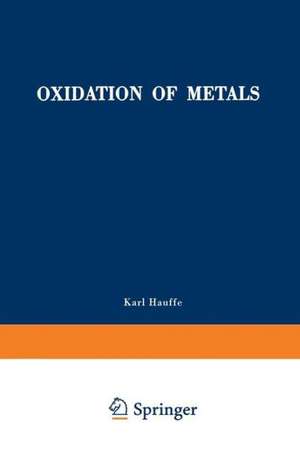Oxidation of Metals
Autor Karl Hauffeen Limba Engleză Paperback – 3 mai 2012
Preț: 396.78 lei
Nou
Puncte Express: 595
Preț estimativ în valută:
75.93€ • 81.19$ • 63.30£
75.93€ • 81.19$ • 63.30£
Carte tipărită la comandă
Livrare economică 18 aprilie-02 mai
Preluare comenzi: 021 569.72.76
Specificații
ISBN-13: 9781468489224
ISBN-10: 1468489224
Pagini: 468
Ilustrații: XII, 452 p. 123 illus.
Dimensiuni: 152 x 229 x 25 mm
Greutate: 0.62 kg
Ediția:1965
Editura: Springer Us
Colecția Springer
Locul publicării:New York, NY, United States
ISBN-10: 1468489224
Pagini: 468
Ilustrații: XII, 452 p. 123 illus.
Dimensiuni: 152 x 229 x 25 mm
Greutate: 0.62 kg
Ediția:1965
Editura: Springer Us
Colecția Springer
Locul publicării:New York, NY, United States
Public țintă
ResearchCuprins
1. Introduction to the Reactions Between Oxidizing Gases and Metals and Alloys.- 2. Lattice Defect Phenomena and Diffusion Processes in Ionic, Covalent, and Metallic Crystals.- 2.1. Lattice Defect Phenomena in Stoichiometric Ionic Crystals.- 2.2. Defect Phenomena in Nonstoichiometric Ionic Crystals.- 2.3. Lattice Defect Phenomena in Regions Near the Surface of Nonstoichiometric Ionic Crystals.- 2.4. Lattice Defect Phenomena and Diffusion Mechanisms in Metals.- 3. The Mechanism of Oxidation of Metals — Theory.- 3.1. Diffusion and Transport Processes in Scaling and Tarnishing Layers.- 3.2. The Wagner Theory of Oxidation.- 3.3. Diffusion and Scaling Coefficients.- 3.4. Calculation of the Absolute Oxidation Rate Constants of Metals for the Parabolic Rate Law.- 3.5. The Effect of Electric Fields on Metal Oxidation.- 4. Scaling Processes in Metals and Alloys with Formation of Thick Protective Layers.- 4.1. Scaling Systems with Ion-Conducting Protective Layers.- 4.2. Scaling Systems with Electron-Conducting Protective Layers.- 4.3. Catastrophic Oxidation.- 4.4. Scaling Systems with Rate-Determining Phase-Boundary Reactions.- 4.5. Scaling Systems with Protective Layers Containing Several Phases.- 4.6. Scaling of Iron Alloys.- 4.7. The Influence of Metal Diffusion in the Alloy Phase on the Scaling Rate.- 4.8. The Mechanism of Internal Oxidation of Alloys.- 5. The Mechanism of the Attack of Sulfur and Sulfur Compounds on Metals and Alloys.- 6. The Oxidation Mechanism of Metal-Carbon Alloys and Carbides.- 7. The Mechanism of Oxide Layer Formation in Aqueous Electrolytes.- 7.1. The Phenomenon of Passivity.- 7.2. The Mechanism of Passive Layer Formation on Metals and Alloys.- 7.3. The Solution Current of Metals with Passive Layers.- 8. A Few Approved Methods of Measurement ofCoating Growth.- 8.1. Use of the Microbalance in Oxidation Apparatus.- 8.2. Gas Volumetric and Manometric Methods for Measurement of the Oxidation Rate.- 8.3. Further Methods for the Measurement of the Thickness of Tarnishing Layers.- Author Index.





![Kitchen Chemistry [With CDROM]: Rsc](https://i4.books-express.ro/bt/9780854043897/kitchen-chemistry-with-cdrom.jpg)
